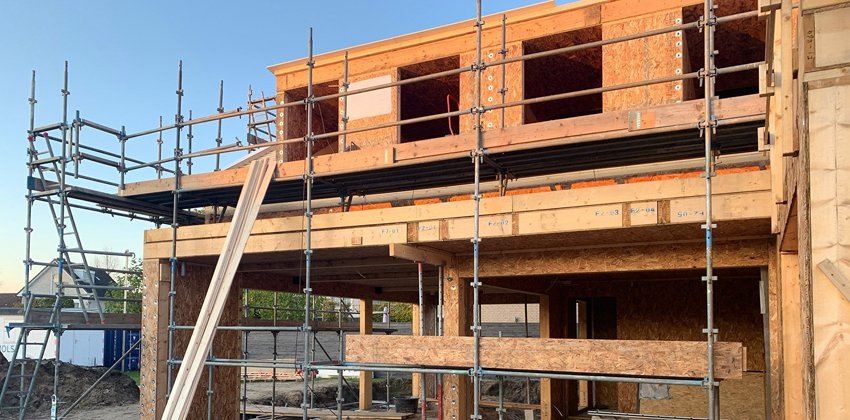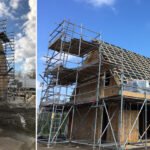
Award-Winning SIP Project Case: Lessons for the Industry
Winning an industry award is not only a mark of excellence but also a signal that a project has delivered something remarkable—something others can learn from. One of Quacent’s recent SIP-based projects has done just that: it received recognition for innovation, sustainability, and performance.
Project Background
The project was initiated to address urgent housing needs in a growing urban area. The municipality required fast delivery, high energy performance, and cost-effective solutions for a community development consisting of multiple family homes.
Quacent was chosen for its ability to deliver Ready-To-Assemble (RTA) SIP kits, which offered predictability in cost, speed, and sustainability. The client’s goals were clear: reduce build time by at least 30%, achieve compliance with nearly zero-energy building (nZEB) standards, and demonstrate replicability for future projects.
Why SIPs Were Chosen
Traditional methods such as brick-and-block construction were considered too slow and too labor-intensive. Modular timber systems were also reviewed, but SIPs offered distinct advantages:
- Faster Enclosure: A complete SIP shell could be erected in less than two weeks.
- Energy Efficiency: SIPs provided U-values that easily met EU regulations.
- Durability: Panels resisted mold, pests, and moisture.
- Cost Control: Prefabrication ensured predictable material use and minimized waste.
The decision to use SIPs was not just about speed—it was about creating a balanced solution that addressed cost, performance, and sustainability simultaneously.
Implementation: From Factory to Site
Step 1: Prefabrication
All panels were precision-cut at Quacent’s facility, packaged by construction phase, and shipped in a single container. This ensured a lean logistics process and minimized site storage.
Step 2: Site Preparation
A small crew prepared the foundations while the panels were en route. The efficiency of just-in-time delivery meant no delays between site work and assembly.
Step 3: Assembly
Within days, walls and roofs were installed. The entire building envelope was made weather-tight in less than ten days, compared to several months using traditional methods.
Step 4: Finishing
Exterior cladding and interior finishes were applied quickly due to the straight, even surfaces provided by the SIPs.
Key Outcomes
The project delivered impressive results:
- 40% Faster Completion: The homes were delivered months earlier than comparable developments.
- Energy Savings: Post-occupancy studies showed heating and cooling demands were reduced by nearly 50%.
- Resident Satisfaction: Occupants reported higher comfort levels thanks to stable indoor temperatures and excellent acoustics.
- Lower Waste: Prefabrication and tight site management cut construction waste by over 60%.
These outcomes not only secured the award but also convinced policymakers and developers that SIPs represent a practical path to solving Europe’s housing crisis.
Lessons Learned
Every successful project offers lessons for the wider industry. This award-winning case highlighted several key takeaways:
- Early Integration Is Crucial
Collaboration between architects, engineers, and SIP suppliers during the design phase ensured smooth assembly and avoided costly adjustments later. - Training Matters
The installation team received training from Quacent supervisors, reducing on-site errors and improving speed. - Logistics Drive Efficiency
By shipping panels in a single container and packaging them by assembly sequence, site organization was simplified and delays were eliminated. - Resident Feedback Counts
User satisfaction surveys confirmed that high-performance envelopes deliver real-world comfort, not just regulatory compliance.
Industry Impact
The recognition of this project has sparked wider interest in SIPs among developers, contractors, and policymakers. Several municipalities are now considering SIPs for public housing programs, schools, and modular developments.
Award juries highlighted the project’s replicability as a key factor—it demonstrated that SIP solutions are scalable, not just experimental. By showing that multiple homes could be delivered quickly and efficiently, the project proved that SIPs can make a real difference at scale.
Benchmark for the Future
Awards are not just about celebrating the past—they set benchmarks for the future. This case established new expectations for the construction industry:
- Speed: Reducing build times by 40% is not exceptional anymore—it should be the new standard.
- Sustainability: Meeting nZEB requirements is not enough; projects should strive to exceed them.
- Comfort: Resident well-being, including indoor air quality and acoustics, must be central to design and construction.
- Scalability: Prefabricated systems like SIPs must be applied beyond pilot projects and into mainstream housing strategies.
Conclusion
The award-winning SIP project is more than a success story—it is a roadmap for the future of European construction. By combining speed, sustainability, and scalability, it proves that housing challenges can be met without compromising quality or comfort.
For the industry, the lessons are clear: integrate early, train crews, streamline logistics, and listen to residents. For policymakers, the message is even clearer: SIPs are not an alternative—they are the benchmark for how housing should be delivered in Europe.





Add a comment